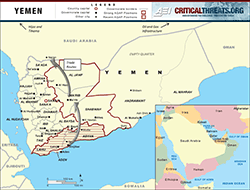{{currentView.title}}
June 21, 2011
Al Qaeda's Yemen Strategy
Finding a resolution to the political crisis in Yemen’s capital, Sana’a, has remained at the forefront of American efforts in Yemen. This focus on the capital ignores long-term challenges in Yemen and developments in southern Yemen, where al Qaeda in the Arabian Peninsula (AQAP) operates. AQAP’s gains in Yemen over the course of the unrest cannot be discounted.
An expert on the Arab world now living in the region has provided the following analysis:
 |
Having watched with no small interest the recent progress of al Qaeda in the Arabian Peninsula (AQAP) and its sympathizers in Yemen, I believe that one can discern the outlines of the organization's territorial strategy. In sum, AQAP seems to be attempting to carve a broad territorial corridor out of the historic heart of Yemen, with the aim of linking the southern Yemeni ports on the Gulf of Aden and the Arabian Sea with the traditional pilgrimage and trade routes in southern Saudi Arabia. The aim of this strategy would seem to be the creation of a terrorist highway of sorts that would facilitate attacks on the Islamic holy cities in the Hijaz, Riyadh and the Najd, and the oil and gas infrastructure located in the Saudi Eastern Province, the United Arab Emirates, and Qatar.
AQAP and its sympathizers have in recent weeks attempted with some success to take and hold territories and towns in several southern provinces. Their progress has naturally accelerated with the disappearance of central government control. Their advances in the provinces of Abyan and Lahij are worthy of particular attention, as they lie directly north of Aden. If AQAP and its supporters can hold these provinces, they will stand a good chance of taking Aden, Yemen's southern capital and principal sea port. Conceivably, all of the south could then fall to them.
Of course, AQAP already has a strong position in the provinces of Ma’rib, Shabwah, and al Jawf. When seen in conjunction with their recent advances in Abyan and Lahij, these circumstances begin to reveal the outlines of AQAP's strategy in Yemen. It would seem that their aim is to secure major lines of communication from the Arabian Sea to southern Saudi Arabia and its traditional trade and pilgrimage routes.
Now often forgotten, these routes are still accessible to the local tribes, who use them to smuggle weapons, narcotics, and illegal immigrants into the Kingdom, despite the staunch efforts of the Saudi Interior Ministry to combat such trade.
Inter alia, these routes run from Zinjibar in Yemen's Abyan province northward through a succession of valleys to Ma’rib, on the edge of the desert. Ma’rib in turn is connected by traditional desert routes to Najran in southern Saudi Arabia. Once one of the great cities of Yemen, Najran has been the main land portal linking Yemen to the interior of Arabia for the last 4000 years. Further routes lead eastward from Najran to Dhahran and the Gulf states on the one hand, and westward to the Tihama coastal plan on the Red Sea and the Hijaz, on the other. Prince Muhammad bin Nayif, Saudi Arabia’s top counter-terrorism official, has often expressed his deep concern regarding the difficulties inherent in identifying and securing these ancient routes leading out of Yemen into the Kingdom and the Gulf States.
Thus, by securing control of Abyan, Lahij, Shabwah, Ma’rib, and al Jawf provinces, AQAP would essentially be taking control of the historical and geographical center of Yemen, which binds the country's western and eastern halves together. Ma’rib was of course the capital of the ancient Kingdom of Sheba or Saba, and thus the original capital of Yemen in classical times, ideally located between the sea and the trade and pilgrimage routes leading to the interior of the Arabian Peninsula. Once again, AQAP is demonstrating impressive strategic judgment grounded in a solid knowledge of Arabia's history and geography.
The band of territory targeted by AQAP is also of uniquely difficult topography. From Zinjibar to Ma’rib it is rugged mountains, and from Ma’rib to Najran it is an extension of the Empty Quarter. Should Yemen lose control of this vital but difficult landscape to al Qaeda, it would be extraordinarily difficult for a foreign military force to retake it on Sana'a's behalf. Certainly the Gulf Cooperation Council (GCC) states could not do so. Even for the U.S. military, taking and holding this portion of Yemen would be a very challenging and costly task.
It might therefore be wiser to adopt an approach focused on controlling the land and sea gateways into al Qaeda's potential zone of occupation. In the south, this would mean taking control, on behalf of the Yemeni government, of Zinjibar and Aden, so as to deny AQAP easy access to the Arabian Sea and the Gulf of Aden. In the north, it would mean assisting the Saudis' efforts to control the Yemeni border separating Ma’rib from Najran. These measures would frustrate AQAP's plans to create a corridor leading from the sea to the interior of Arabia. Thereafter, it would be possible to use military assets to target the AQAP forces trapped within this zone.
Of course, ultimately the real solution to the challenge of AQAP lies in fostering the creation of a competent Yemeni government with effective military forces, supported by liberal aid from its GCC neighbors. Yet achieving this goal will require much effort and a great deal of time. In the mean time, it would be advisable to focus prudent efforts on preventing AQAP from establishing an "emirate" in Yemen's historic heartland.
